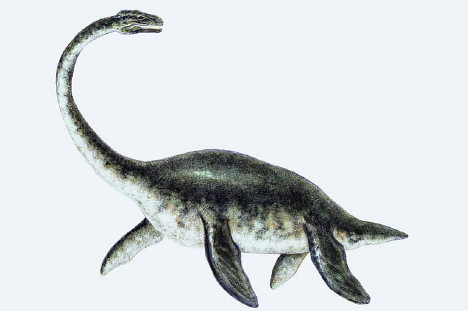Saturday, October 30, 2010
October 30, 2010 : Plesiosaur (Extinct)
Plesiosaur
A plesiosaur (pronounced /ˈpliːsiəsɔər/; Greek: plēsios/πλησιος 'near' or 'close to' and sauros/σαυρος 'lizard') was a type of carnivorous aquatic (mostly marine) reptile. After their discovery, plesiosaurs were somewhat fancifully said to have resembled "a snake threaded through the shell of a turtle", although they had no shell. The common name "plesiosaur" is applied both to the "true" plesiosaurs (Superfamily Plesiosauroidea), which include both long-necked (elasmosaurs) and short-necked (polycotylid) forms, and to the larger taxonomic rank of Plesiosauria, which includes the pliosaurs. The pliosaurs were the short-necked, large-headed plesiosaurians that were the apex predators for much of the Mesozoic.
Plesiosaurs (sensu Plesiosauroidea) appeared at the start of the Jurassic Period and thrived until the K-T extinction, at the end of the Cretaceous Period. While they were Mesozoic diapsid reptiles that lived at the same time as dinosaurs, they were neither dinosaurs nor archosaurs.
Plesiosaurs had a broad body and a short tail. They retained their ancestral two pairs of limbs, which evolved into large flippers. Plesiosaurs evolved from earlier, similar forms such as pistosaurs or very early, longer-necked pliosaurs. There are a number of families of plesiosaurs, which retain the same general appearance and are distinguished by various specific details. These include the Plesiosauridae, unspecialized types which are limited to the Early Jurassic period; Cryptoclididae, (e.g. Cryptoclidus), with a medium-long neck and somewhat stocky build; Elasmosauridae, with very long, inflexible necks and tiny heads; and the Cimoliasauridae, a poorly known group of small Cretaceous forms. According to traditional classifications, all plesiosaurs have a small head and long neck but, in recent classifications, one short-necked and large-headed Cretaceous group, the Polycotylidae, are included under the Plesiosauroidea, rather than under the traditional Pliosauroidea. Size of different plesiosaurs varied significantly, with an estimated length of Trinacromerum being three meters and Mauisaurus growing to twenty meters.
Subscribe to:
Post Comments (Atom)


No comments:
Post a Comment